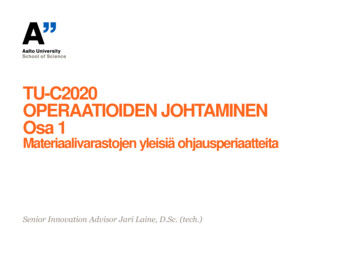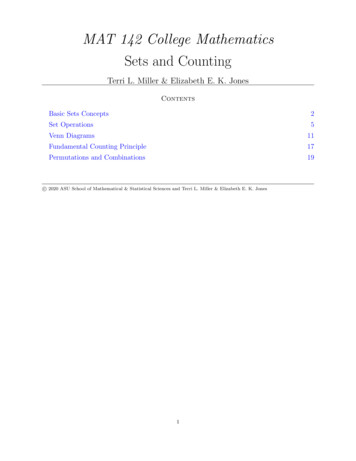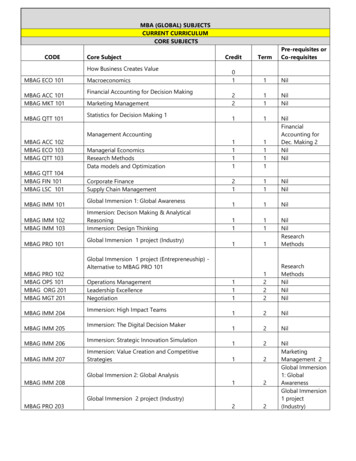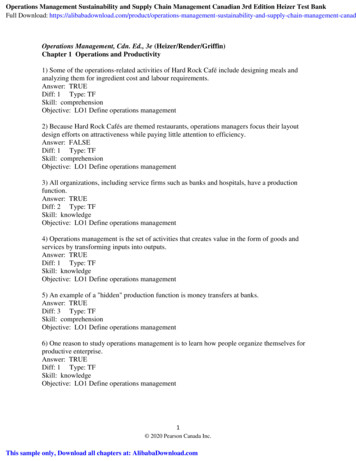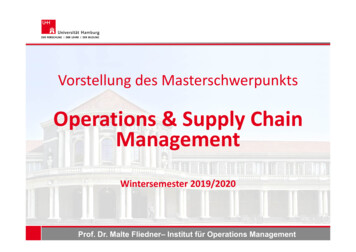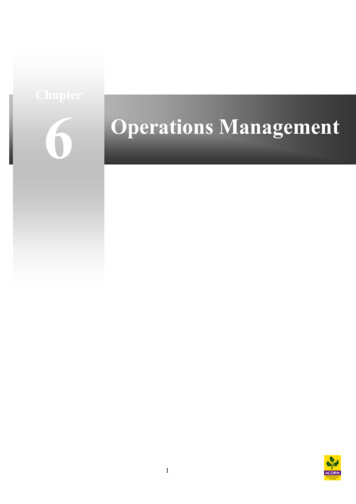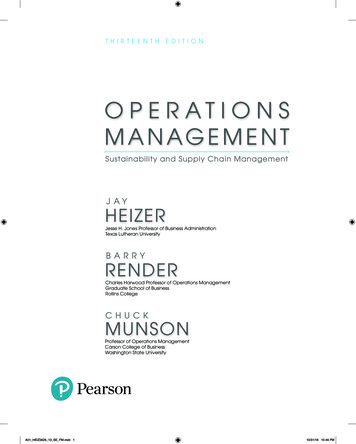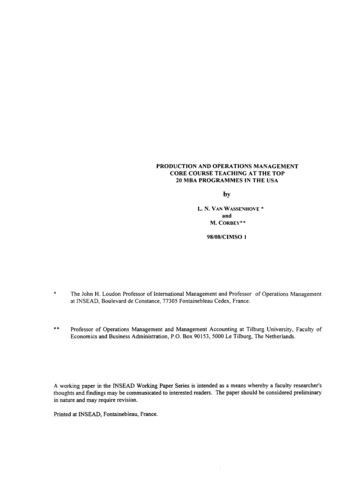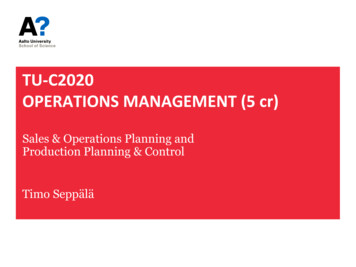
Transcription
TU-C2020OPERATIONS MANAGEMENT (5 cr)Sales & Operations Planning andProduction Planning & ControlTimo Seppälä
SCOR – 5 distinct management processes ofthe FirmSource: http://supply-chain.org/scor
Long term––––Providing strategic resources and capacity to meet long-term demandChoice of strategic locations depending on the marketsDevelopment and utilization of production process technologyLong term planning with supply Medium term– Matching supply with demand– Medium term planning with supply Short term–––––Scheduling of resourcesTracking resource usage & status and labor utilizationTracking customer/production orders and materials usageManaging exceptionsShort term scheduling with supply3Visibility through Enterprise resource planning (ERP)Three time horizons of Plan
ResourceplanningDetailedcapacityplanningSales & ulingFront end:The planningtaskDetailedmaterialplanningEngine:The schedulingtaskMaterialandcapacity plansShop-floorsystemsSuppliersystemsBackend:The executiontaskEnterprise resource planning (ERP)Production Planning & Control (PPC)* System in a Single Firm*In this course, the terms MPC and PPC are used4interchangeably, i.e. they mean the same thing
Demand management Determining or estimating the demand fromcustomers Helping balance demand with supply Converting specific customer requests into promiseddelivery dates – making timely and honest customerpromises possible Serves as a basis for determining the capacity andmaterial needs5
Demand management (continued) Delivery time quotations and available-to-promise Demand forecasting for inventory levels of finishedgoods Proactive demand management, like campaigns,pricing and setting sales targets for the organization Managing new product introductions and phasingout6
CapacityReplacing forecasts with knowledge andprobabilitiesOrdersCurrent dateKnowledgeForecastTime in future - ”Make-to-knowledge”7
Sales and Operations Planning (S&OP)Special thanks to Riikka Kaipia
S&OP originates from related concepts S&OP type of processes have been practiced since the 1950’s, referredto as–––––aggregated production planningmanufacturing resource planning (Olhager et al., 1999)demand-supply planning, demand-supply balancingSupply chain planningintegrated business planning (Bower, 2012). Currently high managerial interest towards S&OP9
Background and motivation Companies are facing increased pressure to be able to match supplywith demand effectively– Increased price competition.– Demand changes grow the need for increased flexibility, shorterlead times, customized products and delivery processes.– Through outsourcing, supply chains have become complexnetworks of organizations, with a high number of relationshipsand stakeholders keeping various positions and roles– Increased pressure for cost-efficiency and flexibility10
Purpose of S&OP Creates a plan - one set of numbers Proactive communication and decision making process Creates common understanding throughout the company about whatthe company is going to produce, deliver, or purchase in the comingperiods of time Key business process applied to balance demand and supply Forum for executive debate – Participation of all stakeholders Decisions made in S&OP impact costs, flexibility or leadtimes11
S&OP Process FormalAgreed-upon timing for each task and meetingShared objectivesIs performed regularly, usually monthlyIncorporates functional plansReconciles supply, demand and new product plans12
How the process runsStepTitleWhat happensOutcomeDay1DemandplanningDemand forecast,, recent ordering patterns, orders in the pipeline,promotions, market indicators, new products and families andcomparisons to prior months or years, field intelligenceUnconstrained demandforecast1-7Demand meeting2Supplyplanning-review the plan, compare it to demonstrated capacity, and perform arough-cut capacity analysis- Supply meetings, may take place in each plantSupply plan11-153Partnershipmeeting(pre-S&OP)Functional meeting finance, marketing, materials, operations, productmanagement, and sales leadersWorking session- review and approval of the forecast- evaluation of performance measures- analysis of the financial impact and the gap between it and thecompany’s annual operating plan- identification of action that can be taken to balance demand and supply- resolution of constraints and escalations.Partnership plan(one set of numbers)Commitment by theorganization.164ExecutivemeetingThe president or CEO, participants from the partnership meeting, humanresources.Execution review presents data and escalations to create understandingon the situation. Reacting to any misalignments with the annualoperating plan, escalation resolution, and preparation for seasonalityand market shifts.To approve one set ofnumbers—to ensure thatfinance, operations, andsales are in concert185FinaliseS&OPS&OP team finalises S&OP figures, links to implementation andoperational planning.1318-19
EscalationsDecisions to be escalated from demand planning or supplyplanning or pre-S&OP to Executive meeting If there are any major issues in demand or supplyplanning, escalate them to the partnership meeting Examples: remarkable signs of market changes, newproduct introductions with uncertain demand, changes inthe environment, competitor actions14
Master Production Schedule (MPS)
Master Production Schedule (MPS)Master Production Schedule answers, for an individual enditem, e.g. on a weekly level, to the following questions:– What product will be produced?– How many should be completed?– When these products are completed?16
Demand management and master production scheduling:the basic principleForecastsMTOETOATOMTSCurrent dateTime into the future - Consume forecasts by orders!17CapacityOrders
Different production ETO)OPPlocationSuppliersIQIMake-toorder -inFinishedmaterials, process (WIP)goodssuppliers parts, componentsand modulesFazerFixed18
Basic Production Process types ENO – High variety, low volume– Project processes (highly customized resources; e.g. Ponsse Scorpion) MTO – High variety, low volume– Jobbing process (operation resource shared with many; e.g. mobilephone PCB Assembly) ATO – Medium variety, medium volume– Batch process (operation has periods repeating itself) MTS – Low variety, high volume– Mass process; Continuous process (operations are repeating itself)19
Basic Service Process types Professional Services– High level of customization– E.g management consultants, lawyers Service Shops– Service is provided via mixes of front and back office activities– E.g. banks, hotels and travel agents Mass services– Low level customization involving limited contact time– E.g. Call centers20
Master Production Schedule MPS is a planned production schedule MPS is stated in items (end item, sub-items and options) inorder to figure out the materials and capacity needs Used as a vehicle for communication with sales – sales canmake accurate order promising against MPS MPS is updated as time goes on, this is called ”rolling throughtime”21
Material Requirements Planning (MRP) Material Requirements Planning (MRP) has themanagerial objective of providing “the right part atthe right time” to meet the schedules for completedproducts MRP provides a formal plan for each part number–raw materials, components, and finished products
Bill of MaterialsThe BOM shows thecomponents andsub-assembliesrequired to producea product
Two main managerial problems related to capacityplanning and management1. Matching capacity with the plans– Either to provide sufficient capacity to execute the plans – or to adjust plans to match capacity constraints2. Trade-off between time and capacity utilization– Fast throughput typically requires underutilization of some capacity inthe system– High priority scheduling results in fast throughput for the high priorityjobs but with the expense of longer throughput times for lowerpriority jobs and underutilization of some capacity24
Role of capacity planning in PPC The primary objective of capacity planning techniques is toestimate capacity requirements early enough to be able tomeet those requirements Flawless execution of the capacity plan allows the firm toavoid unpleasant surprises– Insufficient capacity leads to deteriorating delivery performance– Excess capacity may be a needless expense
Bill of CapacityStd. Setup hoursare spread over thestandard lot sizeTotal hours includeboth std. run timeand std. setup time
Resource profile example (Routing / Process Flow)Production of one unit of product A in period 5requires production activity in periods 3, 4, and 5and in work centers 100, 200, and 300
Basic Production Layout types Fixed position layout– E.g. motorway construction, open heart surgery Functional layout– E.g. supermarkets, bookstore Cell layout– E.g. lap top assembly, mobile phone assembly Line layout– E.g. auto mobile assemply, self service cafeteria Mixed layout28
Week numberCapacity to matchmaximum 03134252819Week number22131671014495243463740313425281922Week numberCapacity to matchaverage demandCapacity is adjusted to demandOutsourceWeek 313428222519131671014Capacity1131671014Different capacity management optionsWeek numberOutsourcing of peaks OROutsourcing the base loadComplimentary productsCapacity29Source : Marja Blomqvist
Capacity increase and reduction Increase capacity by more– overtime & hiring– more tools & machines Reduce capacity requirements by– more subcontracting– alternate routings– revised customer delivery dates30
Choosing the measure of capacity Capacity can be measured in many ways– Labor hours, machine hours, physical units, monetary units, weightetc. The firm’s business needs and constraints should determinethe capacity measure Trends––––––Shrinking portion of direct laborLess clear distinctions between direct and indirect laborReduced ability to change labor capacityOutsourcingFlexible automation/cellular technologiesLean management
Infinite and finite capacity planning Providing sufficient capacity to execute plansrepresents infinite approaches to capacity planning Adjusting manufacturing plans to match capacityconstraints represents finite approaches to capacityplanning32
Capacity e.g. hoursInfinite capacity planning90Other Order book80Open orders70Capacity602 per. Mov. Avg.(Capacity)2 per. Mov. Avg.(Capacity)50403020Time (day or week) PeriodicNo capacity constraintsDoes not consider any adjustment to plans because of planned r6-Mar4-Mar2-Mar026-Feb10
Finite scheduling/loading Schedules work through work centers only to the extent thatthere is capacity available to do so Capacity constraints will define order completion times34
Summarizing principles of Capacity Planningand Production Design Managerial problems related to capacity planning– Matching capacity with the material plans– Trade-off between time and capacity Five level hierarchy of capacity planning decisions–––––Resource planningRough-cut capacity planningCapacity requirement planningFinite loadingInput/output control Supply network perspective– Make or Buy35
Summarizing principles of Capacity Planningand Production Design Capacity plans must be developed concurrently with materialplans if the material plans are to be realized Capacity planning techniques must match the level of detailin particular product, process and layout structures Capacity planning techniques must matched with theparticular company / (customer) circumstances Capacity must be planned, but use of capacity must also bemonitored, controlled and measured
SCOR – 5 distinct management processes ofthe FirmSource: http://supply-chain.org/scor
-review the plan, compare it to demonstrated capacity, and perform a rough-cut capacity analysis - Supply meetings, may take place in each plant Supply plan 11-15 3 Partnership meeting (pre-S&OP) Functional meeting finance, marketing, materials, operations, product management, and sales leaders Working session - review and approval of the forecast
